Spicy and garlicky, these Korean-inspired saucy gochujang noodles deliver a kick of heat and rich umami flavor. This easy recipe is loaded with veggies and has big flavors inspired by Korean cuisine that will satisfy anyone with a noodle craving and a love of spicy food.

The next time you are looking for a healthy recipe with simple Asian-inspired flavors, check out my Ponzu Salmon rice bowls. Succulent ponzu marinated salmon is served over fluffy rice, mixed with snappy, crunchy vegetables and topped with sesame seeds. The best part is it's ready in 30 minutes. Another great recipe that plays with the concept of Asian noodles in a very fresh veggies way is my Sesame Spaghetti Squash Noodles with Broccoli.
Ever since my husband introduced me to Korean food, I've been hooked. Much of our courtship and love blossomed over shared meals, introducing each other to our favorite flavors and discovering delicious foods as a newly dating couple. About 5 years into dating we met Marja Vongerichten, wife of the great chef Jean George Vongerichten and accomplished cookbook author herself. Her enthusiasm for Korean cooking and the flavors of her heritage and the joy that she shared in making her recipes inspired me to explore these flavors in my own kitchen with Jordan as my enthusiastic test audience (he is Korean in case you didn't know).
This recipe for saucy gochujang noodles is one of my favorite recipes inspired by our late-night meals in K-town and the now-closed Woo Lae Oak in NYC. By using rice noodles this recipe is gluten-free (as long as you use a GF soy sauce) and mimics the springy texture of Dukboki (Korean rice cakes) one of my favorite Korean dishes.
You'll Love this Recipe
- Restaurant-worthy flavors at home. These spicy noodles are alive with complex flavors that taste more like they came from a restaurant than from home cooking.
- Tried and True – These spicy Korean gochujang noodles have become one of our favorite Korean-inspired dishes to cook at home. They have stood the test of time over the years for their easy preparation and consistently satisfying flavor.
- Simple ingredients = big results – It may surprise you to discover how much big flavor you can get from just a few ingredients. Owing to the tremendous flavor quotient is the Gochujang paste which is a flavor powerhouse in its own right. This recipe is a great introduction to this versatile flavor bomb.
Let's Get Cooking!
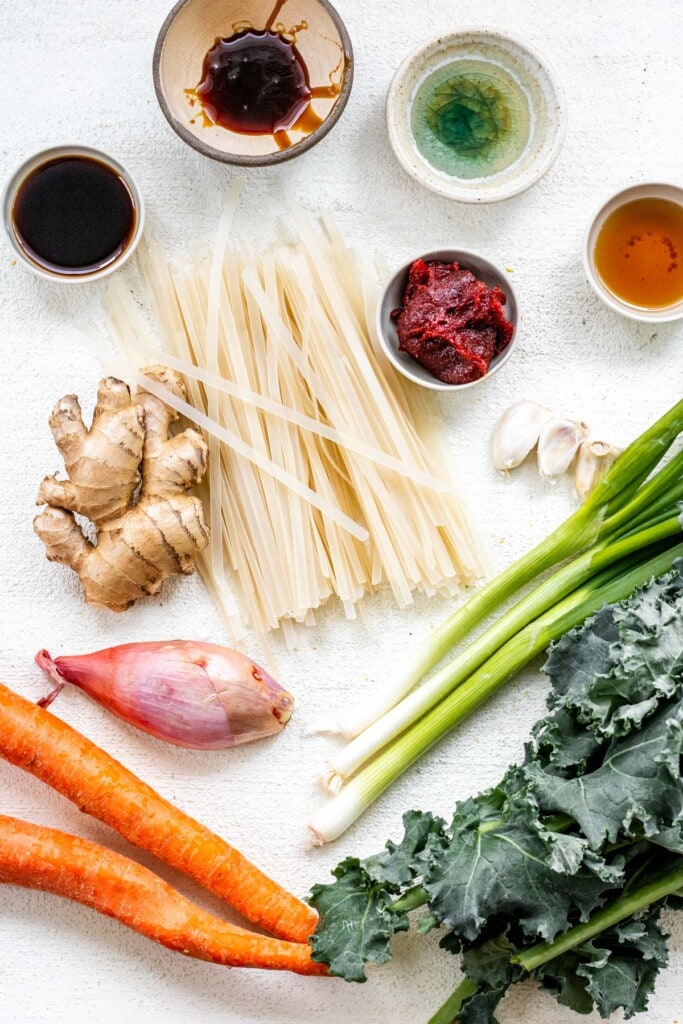
Ingredients and Helpful Substitution Tips
Detailed measurements and ingredients can be found within the recipe card at the end of this post.
- Gochujang – A staple of Korean Cooking. This thick, sticky, and fiery paste is made from fermented soybeans, salt, and glutinous rice, it's a staple of Korean cooking and used in marinades, sauces, and as a flavor booster in soups and stews. It can be found in your local Asian market as well as some conventional grocery stores. It is the base of this spicy gochujang sauce. Most gochujang contains gluten, if you want a GF version of this recipe use GF gochujang (it does exist) Note: This is also sold as ‘fermented Korean chili paste', Korean fermented chili paste and fermented chile paste. More often in non-asian markets, it may have one of these names on the label.
- Rice noodles – I used a Taste of Thai Linguine rice noodles. It sounds strange because this is a Korean-style dish and here I am recommending a Thai-style noodle in the shape of a popular Italian cut. I found that these wide noodles created a very satisfying bite with a perfect noodle-to-sauce-to-vegetable ratio. The wider noodle more closely mimics the mouthfeel you might get from a Korean rice cake and holds up better to the thick sauce.
- Soy Sauce – Or Tamari if making this gluten-free
- Sesame oil and rice vinegar – Classic oil and vinegar flavors for Asian cooking
- Honey – Turns out honey is an excellent counterpart for spiciness. (Think of the hot honey craze of the last decade) the same principle applies here with the honey blending luxuriously with the gochujang's fire.
- Butter – This seems counterintuitive in Asian cooking but I promise, butter gives the sauce amazing dimension and body.
- Fresh ginger – Use fresh- as opposed to jarred, never powdered. The zing and brightness of fresh ginger is vital in this recipe.
- Fresh Garlic – Same as with the ginger, Fresh garlic makes a difference.
- Kale – The heartiness of kale maintains just the right amount of texture against the springy noodles and spicy sauce. Its flavor becomes very neutral in contrast to the bolder elements but its texture has the perfect gentle heartiness. By contrast, a softer green like spinach might become too mushy and soft while also being too tannic.
- Carrot – Carrots are often part of the Korean rice cake dish Dukboki, the inspiration for the flavors in this noodle dish. I love how their natural sweetness is a counterpoint to the spicy notes of the fiery gochujang sauce. Combined, these different elements create an interesting depth of flavor and a wonderful texture alongside the chewy noodles.
- Shallots – For that mellow deep flavor.
- Scallions/ Green onions – to garnish
How to Make This Recipe
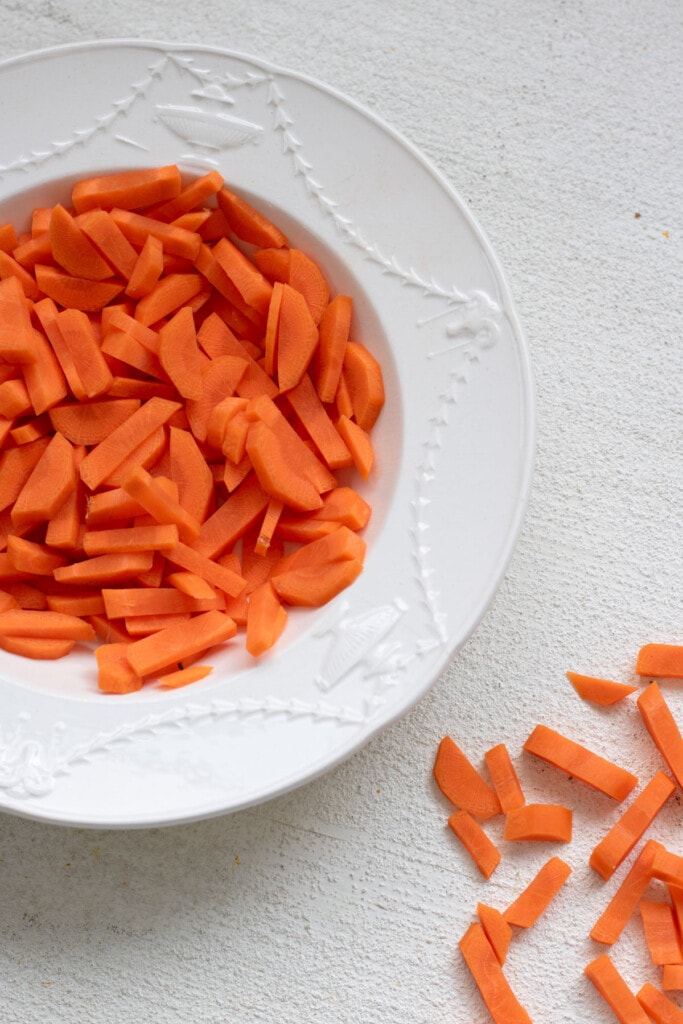
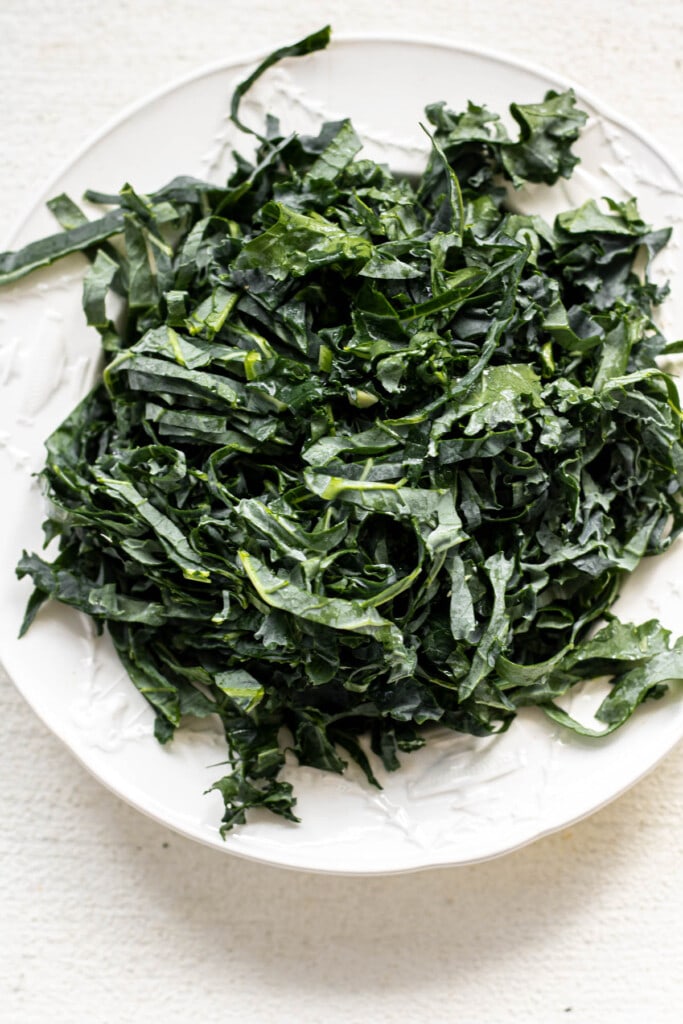
- Prepare Vegetables
Chop carrots in batons/ sticks as shown above. Slice kale in thin slices. To achieve this roll kale leaves into a tight cigar and slice through.
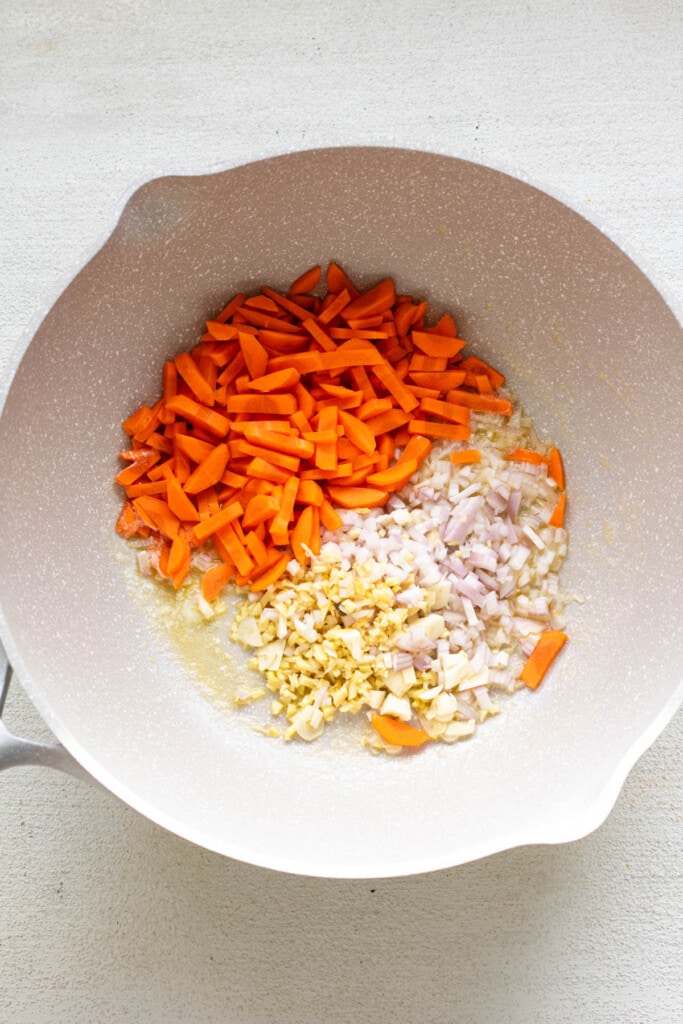
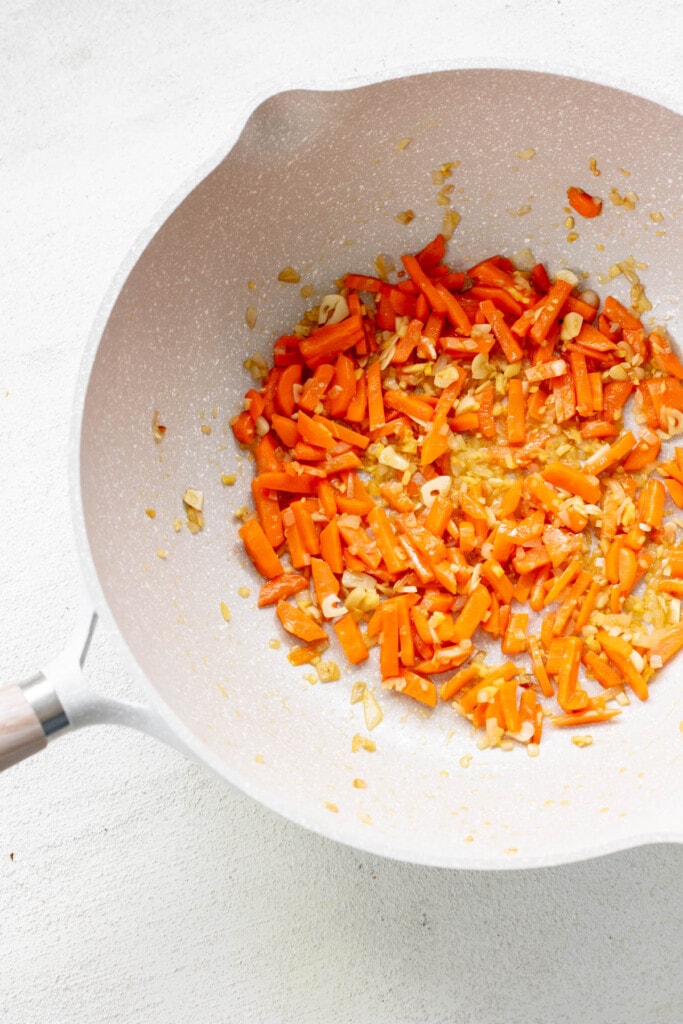
- Saute Veggies
Saute shallot, ginger, garlic, and carrots in ginger until carrots are softened.
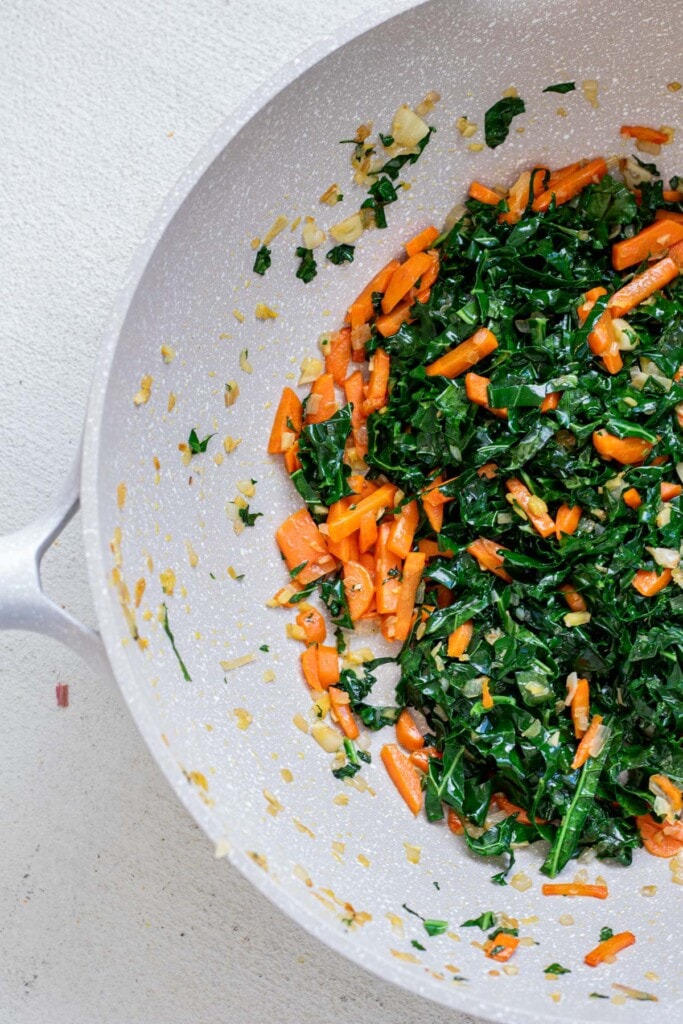
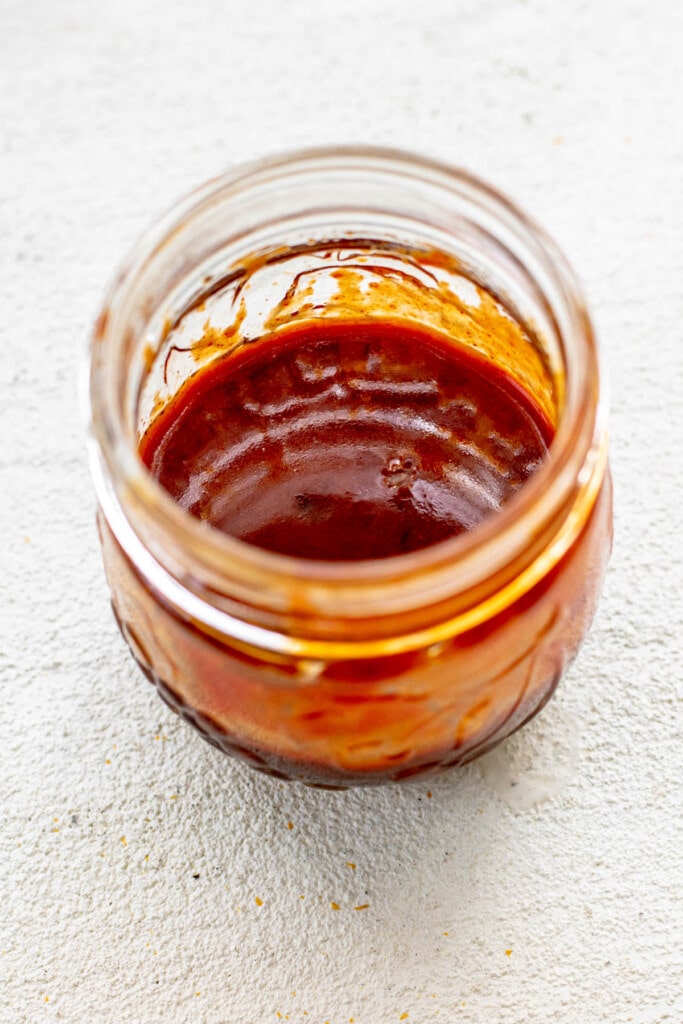
- Add Kale and Make Sauce
Add kale to veggies and saute until tender. Add pasta water to advance cooking. While kale is doing its thing make the gochujang sauce by adding all ingredients to a jar and whisking together until well combined.

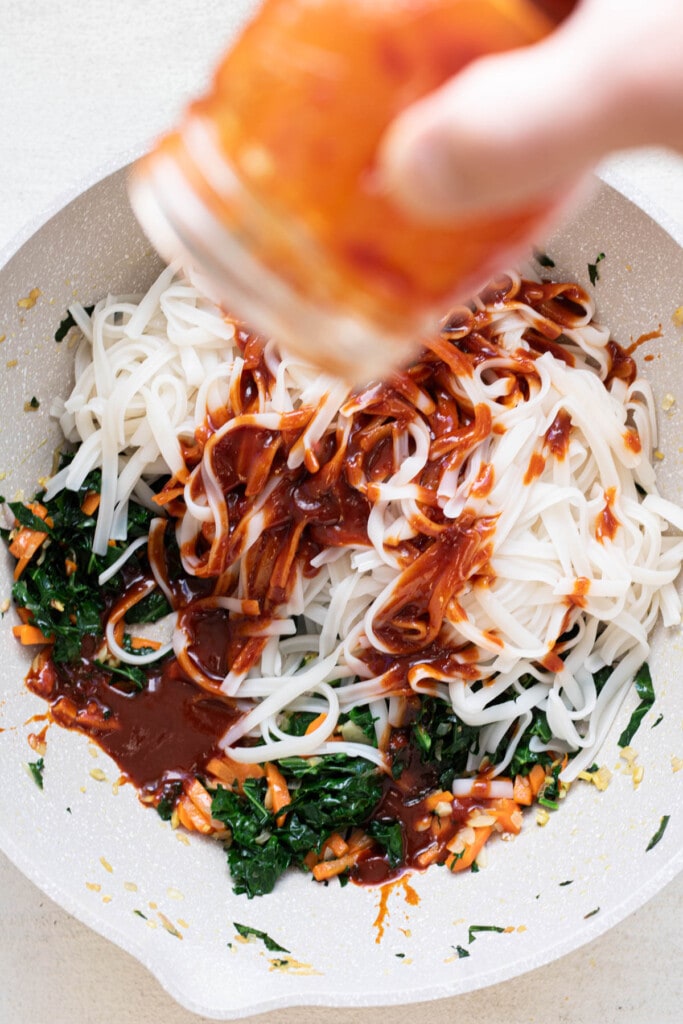
- Noodles + Sauce
Add sauce base to the pan stirring to coat all vegetables. Add the noodles to the saucy veggie mixture, stirring or flipping to thoroughly coat. Add a 1/4 cup of pasta water to loosen the sauce if it gets too thick. Aim for a silky glossy consistency.

Recipe tips
- Spice Level: I realize that not everyone has the same tolerance for spice. Mine is much less than Jordan's. Reduce the amount of gochujang paste by 1/2 a tablespoon to mellow things out. You can also increase the honey and soy for a more present sweet/saltiness.
- Save a cup of the noodle water: If you find that the consistency of the dish needs to be loosened and made more saucy add a1/8 cup of noodle water to your mixture. toss and combine until it becomes silky and glossy.
- Prepare the sauce ahead of time: Make the sauce and store it in a jar in the fridge until you are ready to cook your noodles for a quick meal prep during the week.

Storage, Reheating, and Freezing Instructions
- STORAGE – Can be refrigerated for 5 days in an airtight container
- REHEATING- Warm in a nonstick pan over medium-high heat or reheat in the microwave for 1-2 minutes. Add a splash of water to loosen the noodle mixture is necessary.
- FREEZING- Freezing is not recommended.
FAQ
While this is widely available at Asian markets such as H-mart, it can also be found at Whole Foods and Wegmans as well as other conventional grocery stores more often now than ever before.
For this recipe, I used real Korean gochujang. It comes in a red plastic tub. In regular grocery stores, you may only find brands sold in jars. There are varying spice levels depending on the brand.
It has some kick. If you are super spice-sensitive, this may not be the dish for you. Check out my Sesame Spaghetti Squash Noodles with Broccoli. Otherwise, adjust the spice by reducing the gochujang paste to 1.5 tablespoons.
Dietary Modifications
This recipe is naturally vegan, and vegetarian
- Gluten-Free – Make sure you use GF noodles, GF soy sauce, and GF gochujang
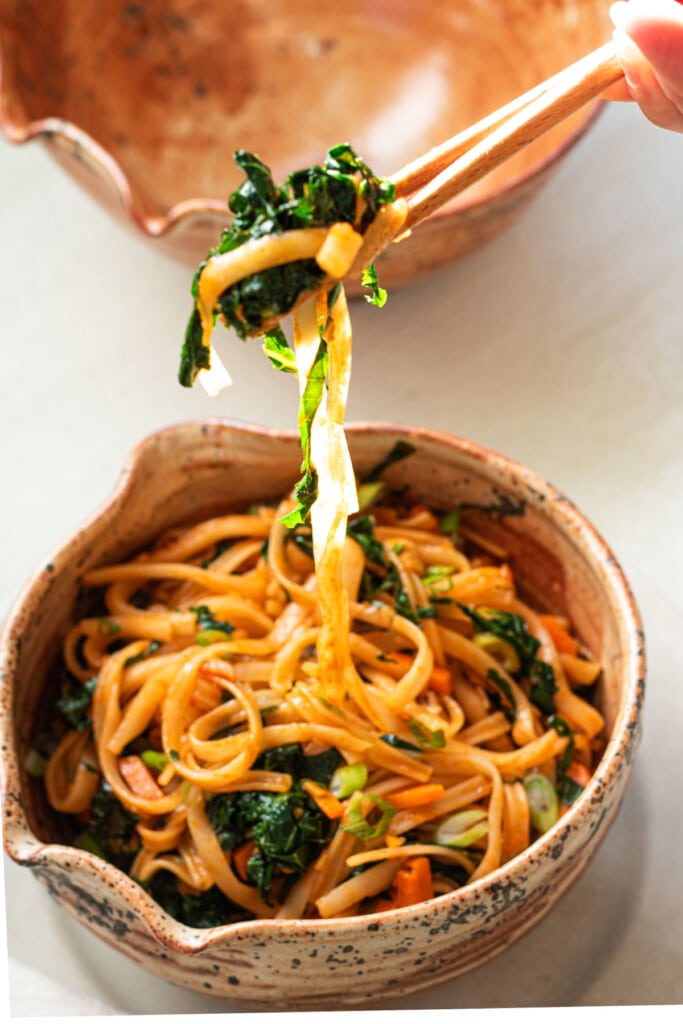
I can’t wait for you to try this! When you make it, snap a photo and tag me on Instagram @abrapappa or use the hashtag #abraskitchen so I can feature your photo!
If you’ve tried this recipe, don’t forget to rate it and leave a comment below. I love to hear from people who’ve made my recipes!

Spicy Gochujang Noodles
Ingredients
- 3/4 lb Thai rice noodles Linguine shape
- 2 tbsp butter
- 1/4 cup shallot finely chopped
- 2 cloves garlic finely chopped
- 2 tbsp fresh ginger about 1.5 inch piece finely chopped
- 1 large carrot
- 4 cups Kale sliced thin ( Should measure about 4 cups after it is sliced)
- 2 tbsp gochujang paste
- 4 tsp soy sauce
- 2 tsp sesame oil
- 2 tsp rice vinegar
- 2 tsp honey
- 2 scallions sliced for topping
Instructions
- Bring a large pot of salted water to boil. Cook noodles according to directions, reserve 1 cup of pasta water.
- In a large skillet over medium heat, melt the butter. Add shallot, garlic, ginger, and carrots. Saute for 4-5 minutes until carrots begin to soften, stirring frequently. Add a pinch of salt.
- Once carrots have softened, add 4 cups sliced kale and a few tbsp of reserved pasta water, and cook until softened.
- Make sauce: In a small bowl combine gochujang, soy sauce, sesame oil, rice vinegar, and honey, whisk to combine.
- Add sauce to the pan and stir to coat all vegetables. Toss noodles in the saucy veggie mixture. If needed add 1/4 cup more of reserved pasta water at a time, to loosen the mixture until it is glossy.
- Garnish with scallions.
Notes
- If you'd like the recipe to be less spicy you can reduce the amount of gochujang, but please keep in mind gochujang is spicy and if you are very sensitive to spice this may not be the best recipe for you.
- Produce swaps – You can add cauliflower, broccoli, bell peppers or zucchini very easily to this recipe. You can also swap the kale for any other leafy green like spinach or swiss chard.
- Store leftovers in an airtight container in the fridge for a few days and reheat in the microwave or on the stove top.


















